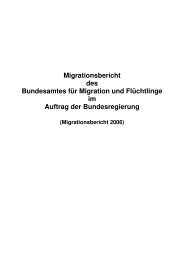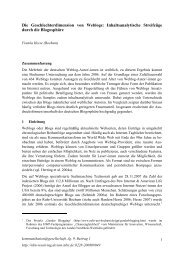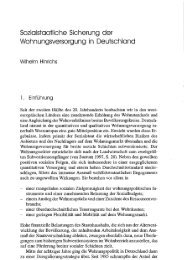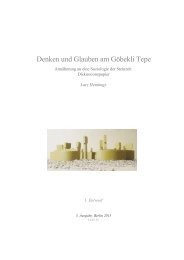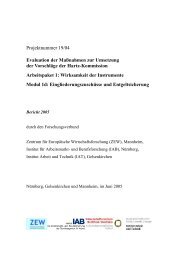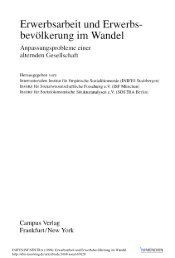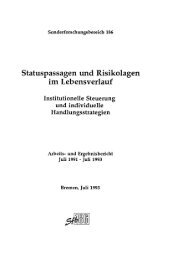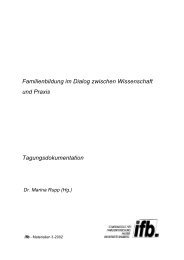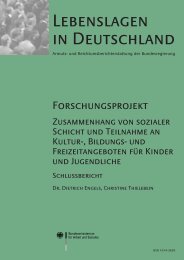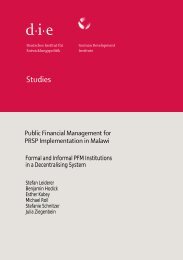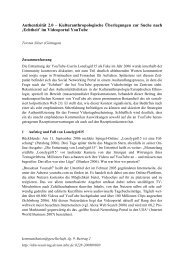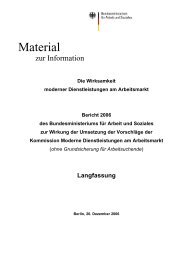- Seite 1:
Sharing Knowledge: Scientific Commu
- Seite 4 und 5:
Tagungsberichte Herausgegeben vom I
- Seite 6 und 7:
Die Deutsche Bibliothek - CIP-Einhe
- Seite 8 und 9:
6 Inhalt Infrastrukturen für innov
- Seite 11:
Vorwort Zur neunten Frühjahrstagun
- Seite 14 und 15:
12 Heike Andermann ted, in 1994-199
- Seite 16 und 17:
14 Heike Andermann schaftlerInnen e
- Seite 18 und 19:
16 Heike Andermann tung beibehalten
- Seite 20 und 21:
18 Heike Andermann NBII). 26 Für d
- Seite 23 und 24:
Qualitätssicherung und Nutzung von
- Seite 25 und 26:
Qualitätssicherung und Nutzung von
- Seite 27 und 28:
Qualitätssicherung und Nutzung von
- Seite 29 und 30:
Qualitätssicherung und Nutzung von
- Seite 31 und 32:
Qualitätssicherung und Nutzung von
- Seite 33 und 34:
Qualitätssicherung und Nutzung von
- Seite 35 und 36:
Qualitätssicherung und Nutzung von
- Seite 37 und 38:
Qualitätssicherung und Nutzung von
- Seite 39 und 40:
vascoda Das gemeinsame Portal von I
- Seite 41 und 42:
vascoda - Das gemeinsame Portal von
- Seite 43 und 44:
vascoda - Das gemeinsame Portal von
- Seite 45 und 46:
vascoda - Das gemeinsame Portal von
- Seite 47:
vascoda - Das gemeinsame Portal von
- Seite 50 und 51:
48 Klaus Hahn Abstract The advancem
- Seite 52 und 53:
50 Klaus Hahn her“ [6]). So wäre
- Seite 54 und 55:
52 Klaus Hahn men auch als Begriff
- Seite 56 und 57:
54 Klaus Hahn Arbeiten notwendig (>
- Seite 58 und 59:
56 Klaus Hahn Fazit Zur effektiven
- Seite 61 und 62:
Unterstützung kooperativer Verfahr
- Seite 63 und 64:
Unterstützung kooperativer Verfahr
- Seite 65 und 66:
Unterstützung kooperativer Verfahr
- Seite 67 und 68:
Unterstützung kooperativer Verfahr
- Seite 69 und 70:
Unterstützung kooperativer Verfahr
- Seite 71 und 72:
Unterstützung kooperativer Verfahr
- Seite 73 und 74:
PhysNet und seine Spiegel - Das Pro
- Seite 75 und 76:
PhysNet und seine Spiegel - Das Pro
- Seite 77 und 78:
PhysNet und seine Spiegel - Das Pro
- Seite 79 und 80:
PhysNet und seine Spiegel - Das Pro
- Seite 81 und 82:
PhysNet und seine Spiegel - Das Pro
- Seite 83 und 84:
PhysNet und seine Spiegel - Das Pro
- Seite 85 und 86:
Online-Hochschulschriften für die
- Seite 87 und 88:
Online-Hochschulschriften für die
- Seite 89 und 90:
Online-Hochschulschriften für die
- Seite 91 und 92:
Online-Hochschulschriften für die
- Seite 93 und 94:
Online-Hochschulschriften für die
- Seite 95:
Online-Hochschulschriften für die
- Seite 98 und 99:
96 Rudi Schmiede, Stephan Körnig s
- Seite 100 und 101:
98 Rudi Schmiede, Stephan Körnig s
- Seite 102 und 103:
100 Rudi Schmiede, Stephan Körnig
- Seite 104 und 105:
102 Rudi Schmiede, Stephan Körnig
- Seite 106 und 107:
104 Rudi Schmiede, Stephan Körnig
- Seite 108 und 109:
106 Rudi Schmiede, Stephan Körnig
- Seite 110 und 111:
108 Jutta von Maurice strument lief
- Seite 112 und 113:
110 Jutta von Maurice bare Kopien v
- Seite 114 und 115:
112 Jutta von Maurice einschließli
- Seite 116 und 117:
114 Jutta von Maurice hebungen. Dem
- Seite 118 und 119:
116 Jutta von Maurice http://www.df
- Seite 121 und 122:
Maßnahmen zur Förderung der Infor
- Seite 123 und 124:
Maßnahmen zur Förderung der Infor
- Seite 125 und 126:
Maßnahmen zur Förderung der Infor
- Seite 127 und 128:
Maßnahmen zur Förderung der Infor
- Seite 129 und 130:
Maßnahmen zur Förderung der Infor
- Seite 131 und 132:
Maßnahmen zur Förderung der Infor
- Seite 133 und 134:
LIMES - A System for a Distributed
- Seite 135 und 136:
LIMES - A System for a Distributed
- Seite 137 und 138:
LIMES - A System for a Distributed
- Seite 139:
LIMES - A System for a Distributed
- Seite 142 und 143:
140 Frank Oldenettel, Michael Malac
- Seite 144 und 145:
142 Frank Oldenettel, Michael Malac
- Seite 146 und 147:
144 Frank Oldenettel, Michael Malac
- Seite 148 und 149:
146 Frank Oldenettel, Michael Malac
- Seite 150 und 151:
148 Frank Oldenettel, Michael Malac
- Seite 152 und 153:
150 Frank Oldenettel, Michael Malac
- Seite 154 und 155:
152 Frank Oldenettel, Michael Malac
- Seite 156 und 157:
154 Frank Oldenettel, Michael Malac
- Seite 158 und 159:
156 Frank Oldenettel, Michael Malac
- Seite 160 und 161:
158 Judith Plümer prints werden du
- Seite 162 und 163:
160 Judith Plümer modification, th
- Seite 164 und 165:
162 Judith Plümer The summarizers
- Seite 166 und 167:
164 Judith Plümer based on a few p
- Seite 168 und 169:
166 Judith Plümer Migration from H
- Seite 170 und 171:
168 Judith Plümer Contact Judith P
- Seite 172 und 173:
170 Dennis Reil für traditionelle
- Seite 174 und 175:
172 Dennis Reil gartner (2002) ist
- Seite 176 und 177:
174 Dennis Reil können. Wichtig f
- Seite 178 und 179:
176 Dennis Reil nahezu identisch, s
- Seite 180 und 181:
178 Dennis Reil Insgesamt kann also
- Seite 183 und 184:
Reflections on the Value Chain of S
- Seite 185 und 186:
Reflections on the Value Chain of S
- Seite 187 und 188:
Reflections on the Value Chain of S
- Seite 189 und 190:
Reflections on the Value Chain of S
- Seite 191 und 192:
Reflections on the Value Chain of S
- Seite 193:
Reflections on the Value Chain of S
- Seite 196 und 197:
194 Natascha Schumann, Wolfgang Mei
- Seite 198 und 199:
196 Natascha Schumann, Wolfgang Mei
- Seite 200 und 201:
198 Natascha Schumann, Wolfgang Mei
- Seite 202 und 203:
200 Natascha Schumann, Wolfgang Mei
- Seite 204 und 205:
202 Natascha Schumann, Wolfgang Mei
- Seite 207 und 208:
ViFaPhys - Virtuelle Fachbibliothek
- Seite 209 und 210:
ViFaPhys - Virtuelle Fachbibliothek
- Seite 211 und 212:
ViFaPhys - Virtuelle Fachbibliothek
- Seite 213 und 214:
ViFaPhys - Virtuelle Fachbibliothek
- Seite 215 und 216:
Weiterentwicklung von digitalen Bib
- Seite 217 und 218:
Weiterentwicklung von digitalen Bib
- Seite 219 und 220:
Weiterentwicklung von digitalen Bib
- Seite 221 und 222:
Weiterentwicklung von digitalen Bib
- Seite 223 und 224:
Weiterentwicklung von digitalen Bib
- Seite 225 und 226:
Weiterentwicklung von digitalen Bib
- Seite 227: Weiterentwicklung von digitalen Bib
- Seite 230 und 231: 228 Markus Kalb, Günther Specht ve
- Seite 232 und 233: 230 Markus Kalb, Günther Specht Di
- Seite 234 und 235: 232 Markus Kalb, Günther Specht Da
- Seite 236 und 237: 234 Markus Kalb, Günther Specht 4.
- Seite 238 und 239: 236 Markus Kalb, Günther Specht pe
- Seite 240 und 241: 238 Markus Kalb, Günther Specht [O
- Seite 242 und 243: 240 Maximilian Stempfhuber � Info
- Seite 244 und 245: 242 Maximilian Stempfhuber Weiterle
- Seite 246 und 247: 244 Maximilian Stempfhuber Zum zwei
- Seite 248 und 249: 246 Maximilian Stempfhuber Abbildun
- Seite 251 und 252: Das didaktische Metadatensystem DML
- Seite 253 und 254: Das didaktische Metadatensystem DML
- Seite 255 und 256: Das didaktische Metadatensystem DML
- Seite 257 und 258: Das didaktische Metadatensystem DML
- Seite 259 und 260: Das didaktische Metadatensystem DML
- Seite 261 und 262: Das didaktische Metadatensystem DML
- Seite 263 und 264: Das didaktische Metadatensystem DML
- Seite 265 und 266: Das didaktische Metadatensystem DML
- Seite 267 und 268: Das didaktische Metadatensystem DML
- Seite 269 und 270: The C 2 M project: a wrapper genera
- Seite 271 und 272: The C 2 M project: a wrapper genera
- Seite 273 und 274: The C 2 M project: a wrapper genera
- Seite 275 und 276: The C 2 M project: a wrapper genera
- Seite 277: The C 2 M project: a wrapper genera
- Seite 281 und 282: The C 2 M project: a wrapper genera
- Seite 283 und 284: The C 2 M project: a wrapper genera
- Seite 285 und 286: Analyse der Qualität der multimedi
- Seite 287 und 288: Analyse der Qualität der multimedi
- Seite 289 und 290: Analyse der Qualität der multimedi
- Seite 291 und 292: Analyse der Qualität der multimedi
- Seite 293 und 294: Analyse der Qualität der multimedi
- Seite 296: Ziele des erstmals von der Initiati




